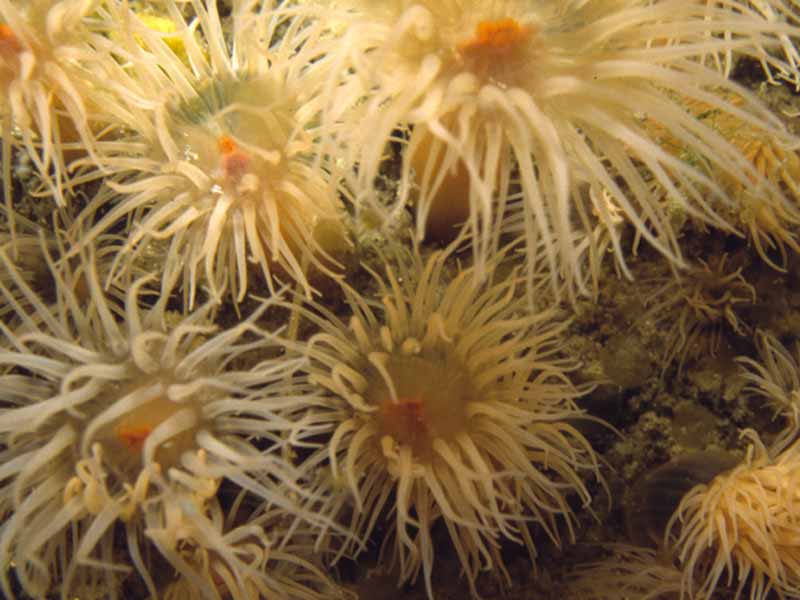Orange anemone (Diadumene cincta)
Distribution data supplied by the Ocean Biodiversity Information System (OBIS). To interrogate UK data visit the NBN Atlas.Map Help
| Researched by | Ken Neal | Refereed by | Admin |
| Authority | Stephenson, 1925 | ||
| Other common names | - | Synonyms | - |
Summary
Description
Diadumene cincta is a small, slender anemone up to 35 mm in height, usually orange in colour. It has up to 200 tentacles on the oral disc which are also orange in colour but paler than the column. The surface of the column is smooth and is dotted with irregularly spaced pores (called cinclides) that serve to release water from the body cavities when the anemone contracts. When contracted, the body appears distorted and the parapet, a fold of tissue surrounding the tentacle-bearing part of the body (the capitulum), is distinct. When Diadumene cincta extends, the parapet folds out and becomes indistinct. If disturbed, this anemone extrudes stinging cell-bearing tentacles called acontia through the mouth to deter attackers.
Recorded distribution in Britain and Ireland
All coasts of Britain often occuring in aggregations. Distribution unknown in Ireland.Global distribution
-Habitat
Attached to hard substrata, particularly bivalve shells in pools in the intertidal and sublittoral down to depths of 40 m. Often found in variable salinity and may be abundant on marina pontoons.Depth range
-Identifying features
- Elongate orange column, almost vermiform when fully extended.
- Parapet and fosse (a groove between the parapet and capitulum) indistinct when extended, become distinct upon contraction.
- Contraction of column asymmetrical, acontia released fairly readily.
- Cinclides present on column.
- Up to 200 long slender tentacles on oral disc, irregularly arranged.
Additional information
Diadumene cincta may be mistaken for small plumose anemones Metridium senile as these two species are found in the same habitat. Diadumene cincta is much more erect and has fewer tentacles than Metridium senile, which has a dumpy appearance.
Listed by
- none -
Bibliography
Hayward, P.J. & Ryland, J.S. 1990. The marine fauna of the British Isles and north-west Europe. Oxford: Oxford University Press.
Howson, C.M. & Picton, B.E., 1997. The species directory of the marine fauna and flora of the British Isles and surrounding seas. Belfast: Ulster Museum. [Ulster Museum publication, no. 276.]
Manuel, R.L., 1981. British Anthozoa. London: Academic Press.[Synopses of the British Fauna, no. 18.]
Stephenson, T.A., 1935. The British Sea Anemones, vol. 2. London: Ray Society.
Datasets
Isle of Wight Local Records Centre, 2017. IOW Natural History & Archaeological Society Marine Invertebrate Records 1853- 2011. Occurrence dataset: https://doi.org/10.15468/d9amhg accessed via GBIF.org on 2018-09-27.
Kent Wildlife Trust, 2018. Kent Wildlife Trust Shoresearch Intertidal Survey 2004 onwards. Occurrence dataset: https://www.kentwildlifetrust.org.uk/ accessed via NBNAtlas.org on 2018-10-01.
National Trust, 2017. National Trust Species Records. Occurrence dataset: https://doi.org/10.15468/opc6g1 accessed via GBIF.org on 2018-10-01.
NBN (National Biodiversity Network) Atlas. Available from: https://www.nbnatlas.org.
OBIS (Ocean Biodiversity Information System), 2025. Global map of species distribution using gridded data. Available from: Ocean Biogeographic Information System. www.iobis.org. Accessed: 2025-07-10
South East Wales Biodiversity Records Centre, 2023. SEWBReC Marine and other Aquatic Invertebrates (South East Wales). Occurrence dataset:https://doi.org/10.15468/zxy1n6 accessed via GBIF.org on 2024-09-27.
Suffolk Biodiversity Information Service., 2017. Suffolk Biodiversity Information Service (SBIS) Dataset. Occurrence dataset: https://doi.org/10.15468/ab4vwo accessed via GBIF.org on 2018-10-02.
Citation
This review can be cited as:
Last Updated: 11/06/2007



